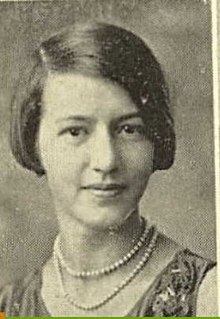Virginia Dare Aderholdt
Virginia Dare Aderholdt | |
|---|---|
 Virginia Aderholdt, 1927 | |
| Born | July 24, 1910 Shenandoah, Virginia, US |
| Died | July 16, 1997 Charlotte, North Carolina, US |
| Other names | Virginia Dare Larsen |
| Occupation | Cryptanalyst |
| Known for | Decrypting Japanese surrender message, August 14, 1945 |
| Spouses | Paul Wehrmeister McDole (m. 1957; died 1969)
|
Virginia Dare Aderholdt was an Arlington Hall cryptanalyst and Japanese translator. She decrypted the intercepted Japanese surrender message at the close of World War II on August 14, 1945.
Early years
Virginia Aderholdt was the daughter of Oscar Wrey Aderholdt, a Lutheran clergyman, and Genolia Ethel Powlas.[1] As a twelve-year-old student, Aderholdt took third place in a state spelling competition.[2] Aderholdt graduated with honors from Wyandotte High School in Kansas. She later studied at Mitchell Community College and Lenoir–Rhyne University in North Carolina, and Bethany College in West Virginia,[3] and Teachers College, Columbia University in New York. Aderholdt also studied at the Biblical Seminary in New York and the Tokyo School of Japanese Language and Culture in Tokyo.
A grade school teacher, Aderholdt taught at the Kansas State School for the Blind. She spent four years in Japan.[when?][4]
Cryptanalyst

During World War II, Aderholdt worked at Arlington Hall decrypting and translating Japanese messages, particularly those in an older diplomatic code, JAH. Because she was fluent in Japanese, she could decrypt and translate simultaneously.[5][6] At noon, August 14, 1945, Arlington Hall received an intercept in JAH from Tokyo to the Japanese Embassy in Bern, Switzerland, announcing the Japanese surrender. Aderholdt decrypted and translated the message, which was sent in Japanese and English. The decrypt was telephoned to military intelligence, and at 7 p.m. that evening, President Harry Truman announced the surrender. The war was over.
Later years
Aderholdt was the only musical missionary sent to Japan by the United Lutheran Church in America. She worked for ten years in Japan as a musical training teacher at the Shokei College School for Girls at Kumamoto, Japan. [4] In November 1957 she delivered a talk on her work at United Lutheran Church, Langley Park, Maryland.[7] She was married twice: first to Paul Wehrmeister McDole, a music teacher, and later to Aksel Christian Larsen, a Lutheran minister. She died of pancreatic cancer in 1997.
See also
References
- ^ "Hickory daily record. (Hickory, N.C.) 1915-current, August 07, 1920". Hickory Daily Record. Vol. 5, no. 270. Hickory, North Carolina. 1920-08-07. p. 3, col. 4. ISSN 1061-5628. Retrieved 2020-03-28.
Peery-Powlas: ... Mendelssohn's march was sounded for the entrance. ... The music was furnished by little ten-year-old Virginia Aderholdt, niece of the bride.
- ^ "(no title)". The News & Observer. Raleigh, North Carolina. 30 November 1922. p. 1.
{{cite news}}: Cite uses generic title (help) - ^ Comins, Linda (21 April 2019). "'Code Girls' Included Bethanians". Archived from the original on 27 October 2019. Retrieved 28 March 2020.
While many of Arlington Hall's language units were headed up by j-boys, JAH [a Japanese code] was handled by a woman named Virginia Dare Aderholdt. According to a memo, Aderholdt graduated from Bethany College in West Virginia — Wilma Berryman's alma mater — which was a four-year college founded by the Christian Church (Disciples of Christ), and offered a first-rate language department and a commitment to good causes. Many graduates did missionary work abroad. Virginia Aderholdt had spent four years in Japan, and the JAH code now was her baby. She owned that code.
- ^ a b "Music Missionary to Speak". Rocky Mount Telegram. Rocky Mount, North Carolina. 4 December 1954. p. 2.
- ^ Mundy, Liza (10 October 2017). Code girls : the untold story of the American women code breakers of World War II (Second prt. ed.). New York. pp. 326–329. ISBN 978-0-316-35253-6. OCLC 972386321.
{{cite book}}: CS1 maint: location missing publisher (link) - ^ McNaughton, James C. (2006). "Chapter 7; MIS Nisei Serving in the Continental United States, 1943–1945; Signals Intelligence" (PDF). Nisei Linguists : Japanese Americans in the Military Intelligence Service during World War II. Washington, DC. pp. 214–215. ISBN 0-16-072957-2. OCLC 70149258.
The Army and Navy developed impressive capabilities, codenamed Magic, one of the most closely held secrets of the war, to intercept Japanese radio communications, including Japanese diplomatic message traffic. The U.S. Army Signal Intelligence Service (SIS) located its code-breaking activities at Arlington Hall on the outskirts of Washington, D.C., with an intercept station and technical training school at Vint Hill Farms near Warrenton, Virginia. The Office of Naval Intelligence's counterpart to the SIS, OP–20–G, was at the Mount Vernon Academy in Washington, D.C. To translate intercepted Japanese material, both organizations used language officers and Caucasian civilians such as Harold E. Zaugg, repatriated from Japan in 1942, and Virginia Aderholdt, a former teacher in Japan.
{{cite book}}: CS1 maint: location missing publisher (link) - ^ Evening Star Saturday, Nov 16, 1957 Washington (DC), Page: 7
